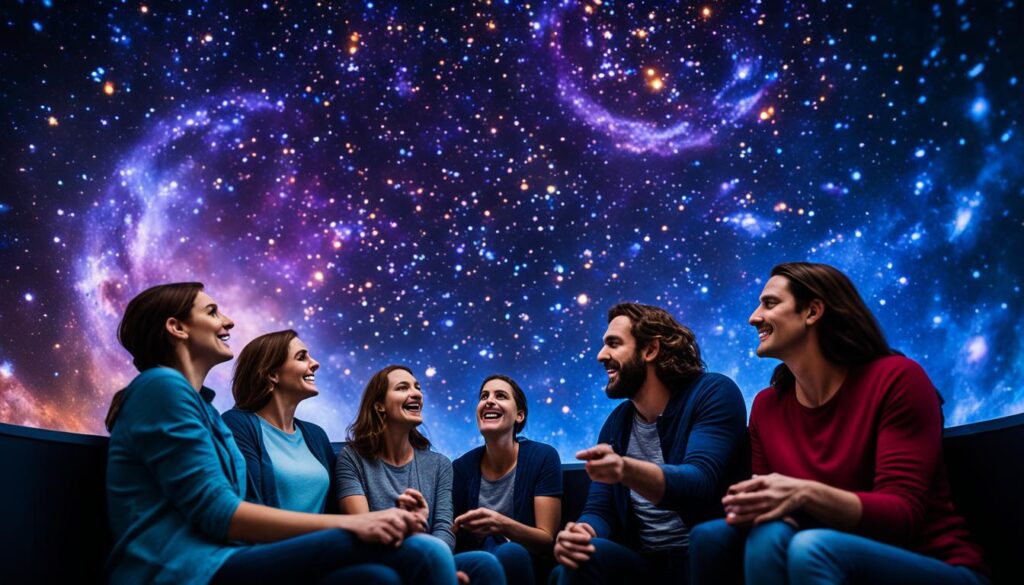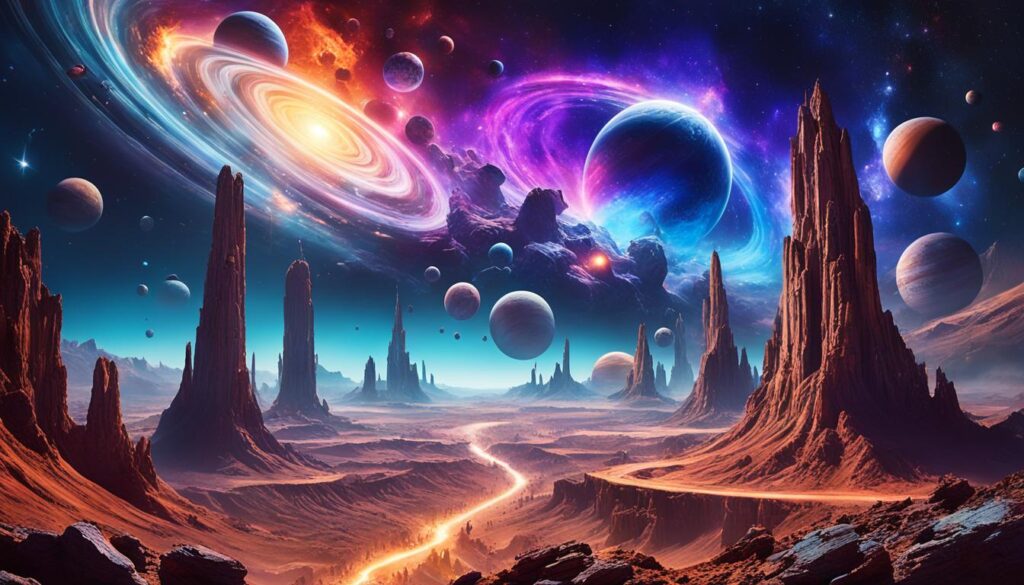“As an Amazon Associate I earn from qualifying purchases.” .
Ready to go beyond Earth and feel amazed? Space travel lets us go on adventures that show us the secrets of the universe. It opens doors to new journeys among the stars.
Exploring space changes how we see the world. It lets us experience zero gravity and see our solar system up close. We learn about planets, stars, and why we dream of reaching them.
Key Takeaways
- Space travel lets us see the vast universe like never before.
- It helps us learn more about space and set new goals for exploring it.
- Living in zero gravity is an amazing part of the journey.
- It shows our strong desire to know and understand the world around us.
- It encourages young people to be interested in science and technology.
Starting a space journey is thrilling, taking us far from our home and sparking curiosity.12 The Earth and Space Expedition Center in Phoenix, Arizona, inspires this by sharing fun exhibits, cool planetarium views, and workshops for everyone.3
The Enigmatic Cosmos
The cosmos is vast and full of wonders, inviting us to uncover its secrets. These are mysteries beyond our current knowledge.
Unveiling the Mysteries of the Universe
Space travel lets us explore the universe’s mysteries. We uncover how it all began and how it changes over time. From galaxies’ births to the secrets of black holes, each journey shows us more.
Stellar Explorations: Charting New Frontiers
Our voyages in space break new ground in knowing the universe. With each find, like new planets or how stars dance, we learn more and our thirst for discovery grows.
The cosmos is a vast and enigmatic expanse filled with celestial wonders, beckoning us to explore its mysteries and unveil the secrets that lie beyond our comprehension.
Thanks to space travel, we see deeper into the universe. We learn the cosmological constant rules its growth. Plus, we get hints about dark matter, found thanks to Fritz Zwicky in 1933.
These discoveries change our understanding and push us to know more about the cosmos.4
| Cosmic Phenomenon | Significance |
|---|---|
| Cosmological Constant | Accelerates the expansion of the Universe, associated with the energy-momentum tensor in Einstein’s equations.4 |
| Vacuum Energy Density | Related to the cosmological constant, representing a low energy scale of a billionth of the electron mass.4 |
Our efforts in stellar travel open up new ways to understand the cosmos. They let us peek into the secrets that keep the universe alive.
Space Travel: A Gateway to Adventure
Space travel is a chance for adventure like we’ve never seen before.5 It’s about leading space missions that are full of invention. And feeling the fun of floating in zero gravity is an exciting challenge. It changes how you see things and grows your world.
New technologies and team efforts from worldwide have made space travel more accessible.5 Thanks to teamwork like the Artemis Accords, we aim for more in human space travel. This leads to thrilling adventures beyond our planet.
Space travel goes beyond going to new places. It’s the adventure itself, which tests what we can do and encourages us to think bigger.
Being in the International Space Station lets us do special science.5 It also helps create tech that changes our lives. The possibility of seeing space up close sparks our curiosity and amazement.
- Pioneering Space Missions
- Life in Zero Gravity
- International Collaborations
- Groundbreaking Discoveries
| Mission | Objective | Significance |
|---|---|---|
| Apollo Program | Landing humans on the Moon | Showed what humans are capable of in space |
| Hubble Space Telescope | Observing deep space | Helped us know more about the universe |
| International Space Station | Long-term research in low Earth orbit | Boosted international unity and science |
If you dream of going into space, space travel is where you should look.5 It’s a place of adventure that breaks the walls of our world and sparks our thoughts. Continuing to explore space leads us to find the marvels of the universe. It calls us to enjoy the excitement of space travel and start a journey that will show us a different view forever.
Earth and Space Expedition Center
Welcome to the Earth and Space Expedition Center in Phoenix, Arizona. It’s a place filled with excitement around space exploration and planetary science. Here, you’ll find interactive exhibits that make learning about space fun for everyone. These exhibits are designed to take you on an exciting adventure through the universe.
Stellar Planetarium Shows
The center’s planetarium shows are a must-see. They let you journey through the stars in a way that’s truly amazing. Imagine lying back and seeing galaxies and nebulae come to life right above you.6

Interactive Exhibits for All Ages
At the Earth and Space Expedition Center, you’ll find a lot to do. There are interactive exhibits for everyone, from kids to adults. You can try activities that feel like real space missions or see what it’s like on other planets. It’s a fun way to learn about space with your family.6
Educational Workshops and STEM Initiatives
The center also has educational workshops and STEM initiatives. They help you understand space and science better. You can join at any age, and the topics range from our solar system to cool space missions like Artemis. There’s even a challenge based on the Apollo 13 mission.6
| Age Group | Topics Covered |
|---|---|
| K-3rd | Solar System, Patterns in the Sky |
| 1st-6th | Artemis Missions, Science Experiments |
| 3rd-5th | Europa Clipper Mission |
| 4th and up | Apollo 13 Challenge |
| 5th and up | Shuttle Heat Shield Challenge |
The Earth and Space Expedition Center does a lot with STEM initiatives. It aims to inspire more young people to explore and love science. This drive for knowledge will help us keep discovering new things in space.6
Exploring the Solar System
We journey through space to discover our solar system. Each planet brings unique wonders. Mercury’s scorching surface and Venus, known as Earth’s twin, invite exploration7.
Earth, full of life and beauty, is a gem in space’s vast darkness. Mars, our red neighbor, hides mysteries yet to be solved. These planets fascinate those who dream of space7.
Mercury: Closest to the Sun
Mercury is closest to the Sun, known for its extreme heat and cratered surface7. It becomes visible to us through space missions like Messenger and BepiColombo. These missions help us understand its secrets.
Venus: Earth’s Sister Planet
Venus, often called Earth’s sister, is covered by a thick atmosphere. This makes it hard to see its surface. Yet, we’ve learned about its tough conditions through missions like Mariner 2 and Venera7.
Earth: Our Cherished Home
Earth, our beautiful home, stands out in the solar system. Its life and landscapes remind us of nature’s wonder. We treasure our planet for its beauty and life7.
Mars: The Red Planet Beckons
Mars, the Red Planet, fires up our curiosity with its rusty look. Efforts like the Viking landings and Mars Orbiter Mission reveal its secrets. It offers promise for future human visits and new discoveries7.
Cosmic Giants
Space travel lets us go beyond the familiar planets. We get to see massive celestial bodies. These wonders show us the vastness of our solar system’s outer parts.
Jupiter: King of the Planets
Jupiter is the biggest planet we know. It’s a giant ball of gas with amazing storms. This cosmic giant has a magnetic field that draws us in. We love exploring its clouds and the Great Red Spot, a storm as big as Earth.
Saturn’s Majestic Rings
Saturn’s majestic rings are a top sight in our solar system. They are made of ice and rock particles. These rings teach us about how our space neighborhood came to be.

Uranus and Neptune: Ice Giants
Uranus and Neptune are known as the ice giants. They let us see another side to our space world. Their blue colors and icy makeup are key to understanding how planets are born and grow.8
The cosmic giants show us how small we are. For example, a Giant Arc discovered by Alexia Lopez is 3.3 billion light years long. This makes it just a small part of the visible Universe. The Hercules-Corona Borealis Great Wall is 10 billion light years long, showing us another huge part of space.8
The chance of structures like the Giant Arc and the Hercules-Corona Borealis Great Wall forming by luck is very, very low. It’s about 0.0003%.8
Humanity’s Quest for the Stars
Our quest for knowledge and exploration has brought us to the stars. Through efforts like the Apollo program and the Voyager probes, we’ve expanded our cosmic understanding5. Space missions not only open new frontiers but also provide a unique experience. They challenge our understanding with life in zero gravity.
Pioneering Space Missions
NASA’s birth over 50 years ago marked the start of exploring the universe5. The Apollo program is famous for landing humans on the Moon, sparking awe worldwide. The Voyager probes have gone even farther, offering new views of space.
Life in Zero Gravity
Understanding life in zero gravity is a major part of space travel. The ISS, a global effort in space, is where astronauts and scientists work in a unique environment5. Here, they conduct experiments like the Solid Fuel Ignition and Extinction to study fire behavior in space, aiming to enhance safety on future missions5.
The experience of life in zero gravity is eye-opening. It changes how we see the world and places us in a wider cosmic context. It inspires a sense of wonder and a desire for more cosmic exploration.
Space exploration highlights our thirst for knowledge and adventure. It pushes the boundaries of what we can achieve.
Through these space missions and the lessons of life in zero gravity, we keep uncovering the universe’s secrets. This fuels our eager pursuit to understand the stars and where we stand among them.
Future of Space Exploration
Looking ahead, space exploration offers endless chances and big dreams. It tests human limits and leads us to tackle tough challenges to learn and discover more.910 We look to set up homes on Mars and venture to the furthest parts of our solar system. We’re invited to start incredible journeys through space.
New Frontiers and Ambitious Goals
NASA aims to get back to the Moon by 2024. Astronauts will touch down on the Moon’s South Pole, an area full of resources and much to learn.9 This big task pairs with creating new tech, like the Space Launch System, Orion spacecraft, and Gateway module. It all readies us for deep space travel and future Mars missions.9
The space station will be key for new research and tech improvements. It will help us explore the Moon and Mars with both humans and robots.9 NASA works hard to understand the Moon’s resources and set up safe missions to Mars. This helps us imagine living on these places in the future.9
Commercial companies will have a big part in space activities. They’ll launch rockets, send satellites, and move supplies and people. They’ll also build needed space structures close to Earth.9 NASA is pushing for more private use of space near Earth. This will encourage innovation and take space exploration to new heights.9
The future of space exploration is an exciting frontier. It needs our steady focus and working together. We aim to uncover space’s secrets and stretch our limits of achievement.
Besides space work, NASA is also focused on the latest in air technology. It wants the U.S. to lead the world in flying.9 By working on Earth science from space, in the air, and on the ground, we’ll learn a lot about our planet. This will benefit Earth and all who live here.
| Key Initiatives | Description |
|---|---|
| Moon Exploration | Establishing a sustained human presence on the Moon, studying its resources, and preparing for future Mars missions. |
| Mars Exploration | Conducting robotic and eventual human expeditions to Mars, searching for evidence of life and understanding the planet’s history. |
| Aeronautics Research | Developing advanced aeronautics technologies to maintain U.S. leadership in the global aviation economy. |
| Earth Science | Monitoring and studying Earth’s natural and human-induced changes through satellite, airborne, and ground-based observations. |
This journey into space will pave the way for amazing human accomplishments. It will spark inspiration for future generations. And it will finally reveal the universe’s incredible mysteries that have fascinated us for so long.
Sparking Young Minds
Space travel can really get kids thinking. It inspires the next generation of explorers. With STEM programs, places like the Earth and Space Expedition Center help kids fall in love with space and science for life.
Inspiring the Next Generation of Explorers
With exciting space travel experiences, kids get curious and eager to learn more. They get to try out things like being on another planet or learning how rockets work. This makes the next generation of explorers believe in big dreams.
STEM Education Initiatives
The focus is on fun STEM education initiatives that go beyond usual classes. Kids learn the basics of science, math, and more while getting ready for the future.11 The ARISS program lets students talk to the International Space Station, making space exciting to learn about.11 Also, contests like Try Zero-G let young explorers send their experiments to space, sparking their love for science.
By sparking curiosity and a love for science, these programs help keep exploring space alive for many years to come.
Through these programs, kids learn to dream big about space. With 42 million students reached, and over 2.8 million teachers involved, the impact is huge. It inspires kids from 25,000 schools to aim for the stars.
Space Tourism: A New Frontier
The start of space tourism is a thrilling new chapter in space travel. It aims to bring space closer to everyone, letting adventure lovers explore the universe.
Thanks to new tech by private companies, visiting space is getting real. These companies hope to cater to wealthy individuals and billionaires, tapping into a12 market for commercial space travel.
Dreams range from short trips for a feeling of floating to longer space stays. For example, Virgin Galactic’s spaceflights cost12. Blue Origin’s first flight with passengers in 2021 was priced at12.
Other plans include luxury space hotels by companies like Orion Span. These hotels could host visitors in space for an extended time for a big12. These space experiences are for the ultra-rich, but by 2030, the market could be worth12. This shows many are interested in commercial space travel.
Space tourism could open a new frontier of cosmic adventure. It may spark wonder and curiosity beyond what we know on Earth.
Conclusion
Exploring space travel and cosmic exploration makes you see it’s more than just impressive. It goes beyond our world, sparking a constant fascination. We look deep into the universe and study the planets around us, showing our need for learning and adventure13. We also look at the health effects of floating in space without gravity. This helps us plan for living in space in the future13.
Looking ahead to more space exploration, space is full of endless opportunities. We aim to go further and inspire a new wave of explorers. Creating food, mining, and processing in space will keep future space cities going13. Also, new ways to travel, like HLLVs and efficient engines, will cut costs. This means space travel could become a reality for more people13.
In the future, exploring space will need us to think about the environment and how people will live there13. Tackling these issues and working together internationally14, can open vast opportunities for space travel. Look up, let the beauty of space motivate you. Start your journey into this amazing unknown future13.
FAQ
What is space travel?
Why is space travel important?
What can we learn from exploring the solar system?
What is the significance of pioneering space missions?
What is the Earth and Space Expedition Center?
How does space travel inspire young minds?
What is the future of space exploration?
What is space tourism?
Source Links
- https://www.earthandspaceexpeditioncenter.org/from-earth-to-mars-insights-into-planetary-science-at-the-earth-and-space-expedition-center-in-phoenix/
- https://www.earthandspaceexpeditioncenter.org/what-is-space-exploration-and-why-does-it-matter-to-you/
- https://www.apu.apus.edu/area-of-study/math-and-science/resources/why-should-we-explore-space/
- https://avi-loeb.medium.com/the-enigmatic-cosmos-94fbf9b0fbd6
- https://www.nasa.gov/humans-in-space/why-go-to-space/
- https://www.earthandspaceexpeditioncenter.org/expeditions/
- https://www.britannica.com/science/space-exploration/Solar-system-exploration
- https://www.bbc.com/future/article/20230302-the-giant-arcs-that-may-dwarf-everything-in-the-cosmos
- https://www.nasa.gov/specials/60counting/future.html
- https://www.nasa.gov/wp-content/uploads/2023/01/55583main_vision_space_exploration2.pdf
- https://www.nasa.gov/missions/station/inspiring-youth-with-science-in-space/
- https://www.thedrum.com/opinion/2024/02/28/space-travel-the-next-frontier-tourism-it-marketing-opportunity
- https://nss.org/settlement/nasa/75SummerStudy/Chapt8.html
- https://nap.nationalacademies.org/read/18248/chapter/4
“As an Amazon Associate I earn from qualifying purchases.” .



